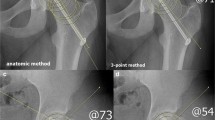Abstract
Introduction
Mechanical factors play a role in pathogenesis of primary osteoarthritis of the hip. Torsion measures were made to detect whether there is a causal relationship between increase or decrease of femoral anteversion, acetabular anteversion, and osteoarthritis. There are no studies in the literature indicating a relationship between axial plane coverage and osteoarthritis of the hip. Deficient axial plane coverage of femoral head may also play a role in pathogenesis of osteoarthritis.
Materials and methods
Thirty patients with primary osteoarthritis of the hip and 29 control cases were included in the study. We used the method of Anda et al. (Acta Radiol Diagn 27:443–447, 1986; Comput Assist Tomogr 15:115–120, 1991) to measure axial plane anterior, posterior coverages in patients with primary osteoarthritis of the hip. The computerized tomography sections and pelvic radiographs indicated good frontal plane coverage and spherical femoral head. In addition to anterior acetabular sector angle, posterior acetabular sector angle, horizontal acetabular sector angles for axial plane coverage detection, femoral anteversion, acetabular anteversion, and McKibbin instability index were also measured.
Results
Posterior coverage was lower at osteoarthritic hips than the control group’s hips (96.0 ± 16.7, 104.2 ± 10.6) (p < 0.05).
Conclusion
The results may indicate that in addition to other mechanical factors, axial plane coverage, especially the posterior coverage deficiency, may play a role in the pathogenesis of hip osteoarthritis.




Similar content being viewed by others
References
Kitaoka HB, Weiner DS, Cook AJ, Hoyt WA, Askew MJ (1989) Relationship between femoral anteversion and osteoarthritis of the hip. J Pediatr Orthop 9:396–404
Terjesen T, Benum P, Anda S, Svenningsen S (1982) Increased femoral anteversion and osteoarthritis of the hip joint. Acta Orthop Scand 53:571–575
Beck M, Kalhor M, Leunig M, Ganz R (2005) Hip morphology influences the pattern of damage to the acetabular cartilage. Femoroacetabular impingement as a cause of early osteoarthritis of the hip. J Bone Joint Surg Br 87:1012–1018
Crawford JR, Villar RN (2005) Current concepts in the management of femoroacetabular impingement. J Bone Joint Surg Br 87:1459–1462
Tanzer M, Noiseux N (2004) Osseous abnormalities and early osteoarthritis: the role of hip impingement. Clin Orthop Relat Res 429:170–177
Anda S, Svenningsen S, Dale LG, Benum P (1986) The acetabular sector angle of the adult hip determined by computed tomography. Acta Radiol Diagn 27:443–447
Anda S, Terjesen T, Kvistad KA, Svenningsen S (1991) Acetabular angles and femoral anteversion in dysplastic hips in adults: CT investigation. J Comput Assist Tomogr 15:115–120
Weiner LS, Kelley MA, Ulin RI, Wallach D (1993) Development of the acetabulum and hip: computed tomography analysis of the axial plane. J Pediatr Orthop 13:421–425
Mose K (1980) Methods of measuring in Legg-Calve-Perthes disease with special regard to prognosis. Clin Orthop Relat Res 150:103–109
Wiberg G (1939) Studies on dysplastic acetabula and congenital subluxation of the hip joint. With special reference to the complication of osteoarthritis. Acta Chir Scand 83(Suppl 58):5–135
McKibbin B (1970) Anatomical factors in the stability of the hip joint in the newborn. J Bone Joint Surg Br 52:148–159
Halpern AA, Tanner J, Rinsky L (1979) Does persistent fetal femoral anteversion contribute to osteoarthritis? Clin Orthop Relat Res 145:213–216
Reikeras O, Bjerkreim I, Kolbenstvedt A (1983) Anteversion of the acetabulum and femoral neck in normals and in patients with osteoarthritis of the hip. Acta Orthop Scand 54:18–23
Reikeras O, Hoiseth A (1982) Femoral neck angles in osteoarthritis of the hip. Acta Orthop Scand 53:781–784
Hubbard DD, Staheli LT, Chew DE, Mosca VS (1988) Medial femoral torsion and osteoarthritis. J Pediatr Orthop 8:540–542
Swanson AB, Greene PW Jr, Allis HD (1963) Rotational deformities of the lower extremity in children and their clinical significance. Clin Orthop Relat Res 27:157–175
Wedge JH, Munkacsi I, Loback D (1989) Anteversion of the femur and idiopathic osteoarthrosis of the hip. J Bone Joint Surg Am 71:1040–1043
Giori NJ, Trousdale RT (2003) Acetabular retroversion is associated with osteoarthritis of the hip. Clin Orthop Relat Res 417:263–269
Menke W, Schmitz B, Schild H, Koper C (1991) Transverse skeletal axes of the lower extremity in coxarthrosis. Z Orthop Ihre Grenzgeb 129:255–259
Fabry G, MacEwen GD, Shands AR Jr (1973) Torsion of the femur. A follow-up study in normal and abnormal conditions. J Bone Joint Surg Am 55:1726–1738
Tönnis D, Heinecke A (1999) Acetabular and femoral anteversion: relationship with osteoarthritis of the hip. J Bone Joint Surg Am 81:1747–1770
Watanabe RS (1974) Embryology of the human hip. Clin Orthop Relat Res 98:8–26
Haene RA, Bradley M, Villar RN (2007) Hip dysplasia and the torn acetabulum. J Bone Joint Surg Br 89:1289–1292
Hodge WA, Carlson KL, Fijan RS, Burgress RG, Riley PO, Harris WH, Mann RW (1989) Contact pressures from an instrumented hip endoprosthesis. J Bone Joint Surg Am 71:1378–1386
Pedersen DR, Brand RA, Davy DT (1997) Pelvic muscle and acetabular contact forces during gait. J Biomech 30:959–965
Witte H, Eckstein F, Recknagel S (1997) A calculation of the forces acting on the human acetabulum during walking. Acta Anat 160:269–280
Acknowledgments
The authors thank statistician Kenan Kose, Asst. Prof., for help in the statistics.
Conflict of interest statement
No benefit in any form has been received or will be received from a commercial party related directly or indirectly to the subject of this article.
Author information
Authors and Affiliations
Corresponding author
Rights and permissions
About this article
Cite this article
Hapa, O., Yüksel, H.Y., Muratlı, H.H. et al. Axial plane coverage and torsion measurements in primary osteoarthritis of the hip with good frontal plane coverage and spherical femoral head. Arch Orthop Trauma Surg 130, 1305–1310 (2010). https://doi.org/10.1007/s00402-010-1086-3
Received:
Published:
Issue Date:
DOI: https://doi.org/10.1007/s00402-010-1086-3




